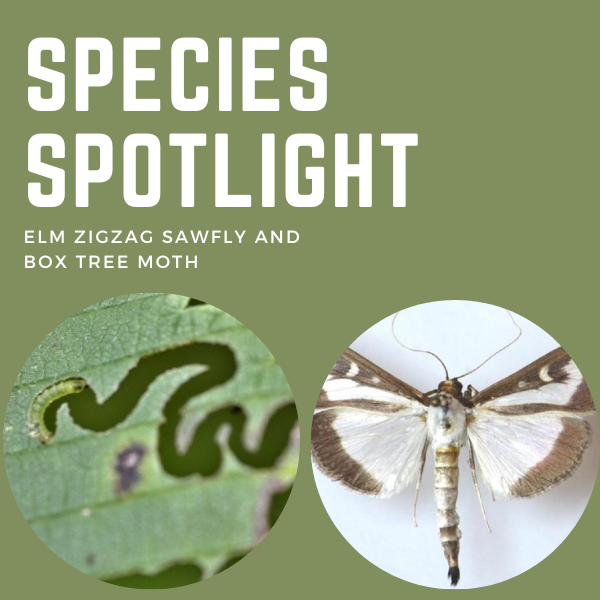This article was featured in the 2022 Autumn Newsletter by Dorothea Duell-NYS Department of Agriculture and Markets, and Megan Pistolese-Shaw-SLELO PRISM.
There are two new invasive species that are encroaching on the SLELO region, the elm zigzag sawfly (EZZ Sawfly) and the box tree moth (BTM).
Feeding exclusively on elm, the elm zigzag sawfly, Aproceros leucopoda, is named after the distinctive zigzag feeding pattern left in leaves by feeding larvae. Feeding can cause significant defoliation, branch dieback, and crown thinning on infested elm trees. Competition between native sawfly species and native elm foliage-feeding species may also become a concern; plus infested trees are more vulnerable to other tree pests and pathogens causing a cascading impact on forest ecology, the economy and societal values (2)(3)(4).
The New York State Department of Environmental Conservation and USDA APHIS have recently confirmed the presence of EZZ-sawfly in St. Lawrence County. Three specimens were collected at the Wildland in Brasher Falls and evidence of EZZ-sawfly feeding patterns were found at the Brasher State Forest, Wilson Hill WMA, and the St. Lawrence State Park. At this time, sawfly populations appear to be at low levels and causing only minor damage.

The Box tree moth (BTM), Cydalima perspectalis, feeds primarily on boxwood (Buxus spp.). While New York and North America do not have native boxwood, the genus is an important commodity in the U.S. nursery industry and is frequently used in landscaping. Heavy feeding by BTM larvae on boxwood foliage and bark causes defoliation of the evergreen shrub, with plant death occurring in many cases. BTM is a strong flier, and with at least two generations each year, populations can grow quickly.

In 2018, BTM was found in Ontario, Canada, and in 2021 it was confirmed in Niagara County, NY, the first known occurrence in the United States. In response to positive trap finds, the New York State Department of Agriculture and Markets (NYSAGM) established a quarantine in December 2021 encompassing all of Erie, Niagara, and Orleans counties in western New York. The United States Department of Agriculture (USDA) followed up with additional regulations in early 2022. Per the regulations, boxwood is allowed into the quarantine zone from other areas, but cannot be taken outside of it. An extensive nursery trapping program is also in place to monitor and respond to the potential spread of the pest.
The public is encouraged to keep an eye out for the elm zigzag sawfly and the box tree moth. Sightings can be reported to iMapInvasives.org or for BTM directly to the New York State Agriculture and Markets Box Tree Moth online reporting form.


